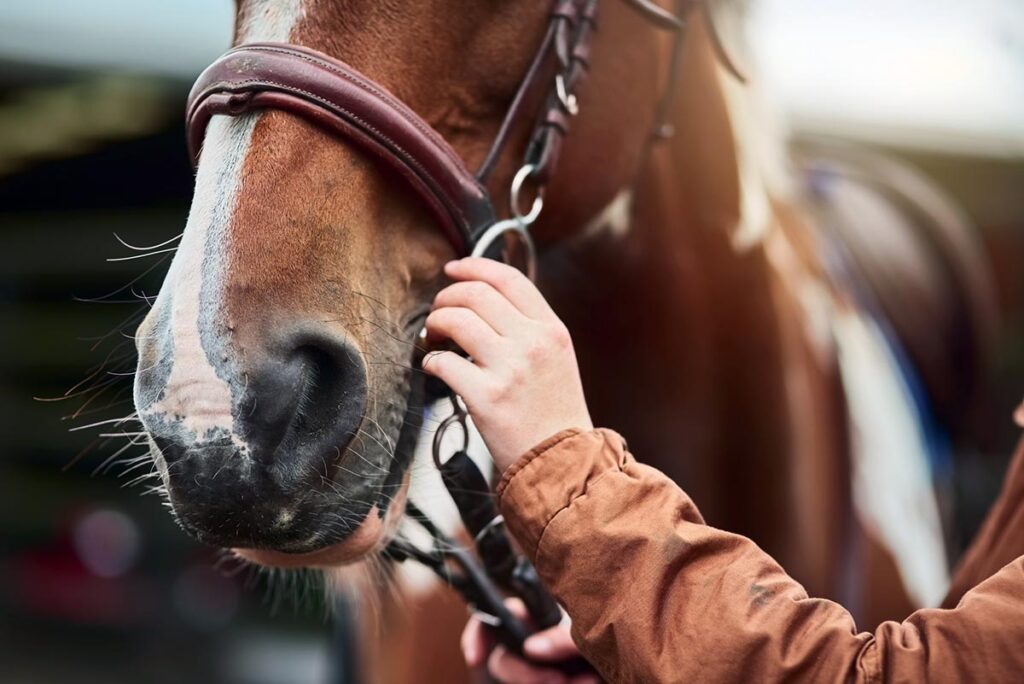When a horse changes hands from one owner to another, they’re not just getting a new person. They’re also transitioning to a new home, herd, routine, and diet. So when you buy a horse—unless it’s one that already lives at the barn where you ride—you’ll want to make that transition as smooth and stress-free as possible. This includes switching him from the brand and type of feed he’s been eating to the one you or your barn manager feed. You’ll want to make the change slowly and carefully to prevent digestive issues such as colic or diarrhea. Horses’ GI tracts, after all, are surprisingly sensitive to change. Here are the steps to follow when changing a horse’s feed.
Step 1: Start with a small amount
Before you even bring your new horse home, ask the seller if they can spare (or if you can buy) at least a week’s worth of the horse’s current feed and hay. This is because you’ll want to introduce the new product gradually while still feeding the old one. For example, start by feeding your horse 75% of his old feed mixed with 25% of the new brand. Such a small amount allows your horse to get accustomed to the new feed without overloading his digestive system.
Step 2: Increase the new feed gradually
Over several days or weeks, slowly increase the amount of new feed added while decreasing the amount of the old feed. As a general rule of thumb, after two or three days you should be able to increase your horse’s ration to 50% old feed and 50% new. In another two or three days, up it to 25% old feed and 75% new. After a couple more days? You guessed it: Transition your horse over to eating exclusively the new feed. You can follow this same protocol for both your horse’s grain and his hay. The gradual introduction of new feed will allow your horse’s digestive system to adjust to the change and reduce the risk of digestive upset.
Step 3: Monitor your horse’s health and appetite

It’s important to keep a close eye on your horse throughout the transition to ensure he’s adjusting well to the new feed. Watch his behavior, energy level, and appetite, and look for signs of digestive upset such as diarrhea or colic. Also make sure he has access to plenty of clean, fresh water. If you notice any issues, introduce the new feed in smaller increments or over longer periods, or call your veterinarian.
Step 4: Consider your horse’s individual needs
Remember, each horse is unique, and some might require slower feed transition times than others. Don’t rush the process; instead, take the time your horse needs to adjust to the new feed. This might mean spacing incremental increases in new feed over weeks instead of days or by 10% instead of 25%. Once your horse has fully transitioned to the new feed, you can adjust the ration based on his body condition, activity level, and nutritional needs. Always read the instructions on the feed bag’s label carefully to make sure you’re providing the appropriate amount.
What if You Don’t Have Access to Your Horse’s Old Feed?
While the process described is the ideal way of changing a horse’s feed, we understand that sometimes it’s just not possible to make a gradual transition. Maybe the seller wasn’t able to provide you with the horse’s old feed, or perhaps it got lost in transit. Regardless, the same principles apply: Go slow, and increase portions gradually. Start by feeding your horse a small ration of his new feed and lots of free-choice, quality forage. If your horse seems to be handling it well (e.g., good appetite, no digestive upset), increase the amount fed gradually (in no more than half-pound increments) every few days until you reach the desired amount as directed on the feed’s label.
Take-Home Message
Prepare to spend at least a week changing your horse’s feed completely from one brand or type to another. By following the steps outlined above, you can make the transition safely and confidently. Remember to be patient, monitor your horse’s appetite and health, provide plenty of fresh water, and consider your horse’s individual needs. And when in doubt, ask a veterinarian or equine nutritionist for advice.
Are you enjoying this content? Sign up for My New Horse’s FREE newsletter to get the latest horse owner info and fun facts delivered straight to your inbox!








